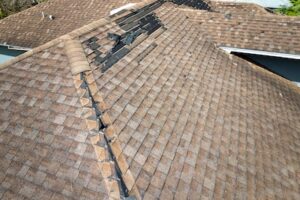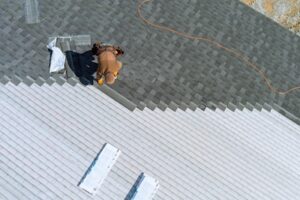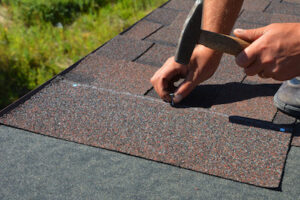Home Guide to the Right Way to Tackle Roof Damage and Prevent Future Problems
Your roof is your home’s first line of defense against the elements, protecting both your family and belongings from damage. Roof damage can lead to costly repairs, interior damage, and even health risks if not addressed promptly and effectively. So, what is the right way to tackle roof damage and prevent future problems?
The right way to tackle roof damage is to identify the issue, assess the damage, call a professional, and make repairs. Then to prevent future problems with your roof, you must perform regular maintenance, proper ventilation, and install extra protective measures.
In this article, we will discuss the right way to tackle roof damage and provide valuable insights and solutions to prevent future problems, ensuring the longevity and safety of your home.

How to Handle Roof Damage Properly
Roof damage can be a significant problem for homeowners, as it can lead to leaks, structural issues, and even safety hazards. If you notice that your roof has been damaged, it’s important to take action as soon as possible to prevent further damage and ensure the safety of your home. Here are some steps to handle roof damage:
1. Identify and Assess the Issue
The first step in addressing roof damage is identifying and assessing the issue. Regular inspections, especially after severe weather events, are essential to detect problems early on. Be on the lookout for signs such as missing or damaged shingles, sagging, water stains on your ceiling, and granules in your gutters. These can indicate issues ranging from minor wear and tear to more serious structural damage.
2. Temporarily Cover the Damage
If you notice any leaks or holes in your roof, it’s important to cover them temporarily to prevent further damage. Use a tarp or plastic sheeting to cover the damaged area and secure it in place with boards or weights. This will help keep out the elements until you can make permanent repairs.
3. Call a Professional
While you may be tempted to fix the damage yourself, it’s important to call a professional roofer to assess and repair the damage. A professional roofer has the expertise and equipment to safely and effectively repair your roof, and can also identify any underlying issues that may have caused the damage in the first place.
Once you’ve identified the problem and have called a professional to inspect the damage, it’s important to determine the appropriate course of action. This may involve a simple repair, partial replacement, or complete roof replacement, depending on the extent of the damage. Consider the following options when tackling roof damage:
DIY Repairs
For minor issues such as a few missing or damaged shingles, you may be able to handle the repairs yourself. Ensure you have the necessary tools and materials, as well as a solid understanding of roofing safety precautions. Research the proper techniques and watch instructional videos online to guide you through the process.
Professional Repairs
If the damage is beyond your expertise or involves potential structural issues, it’s crucial to call in a professional. Roofing repairs can be dangerous and complicated, so it’s best to leave it to the experts. Research and contact a reputable Roofing Contractor to assess the damage and provide an appropriate solution.
Partial Replacement
In some cases, the damage may be isolated to a specific section of your roof. If this is the case, a partial replacement may be the most cost-effective solution. A professional roofing contractor can help you determine if this is the right option for your home.
Complete Roof Replacement
If your roof has reached the end of its lifespan or has sustained severe damage, a complete roof replacement may be necessary. While this is a significant investment, it’s essential to ensure the safety and longevity of your home. Work with a trusted roofing contractor to choose the right materials and installation method for your specific needs.

4. Document the Damage
It’s important to document the damage to your roof for insurance purposes. Take photos of the damage and keep any receipts or invoices from repairs or temporary fixes.
Once your roof has been repaired, it’s important to take steps to prevent future damage.
How to Prevent Future Roofing Issues
In addition to addressing existing damage, it’s crucial to take steps to prevent future problems. Consider implementing the following preventative measures to extend the life of your roof and minimize the risk of damage:
Regular Inspections
Regularly inspect your roof for any signs of damage or wear and tear and make sure to schedule routine roof inspections, especially after extreme weather events, to catch potential problems early. Look for missing or damaged shingles, cracks, and any other issues that may compromise the integrity of your roof. Address any issues immediately to prevent further damage and costly repairs.
Proper Ventilation and Insulation
Proper ventilation is essential to preventing moisture buildup. Ensuring your attic has proper ventilation and insulation can help regulate temperature and moisture levels, preventing damage to your roof and attic from ice dams, condensation, and mold.
Regular Roof Maintenance
Regularly inspect your roof and replace damaged or missing shingles, reseal flashing and vents, and apply a protective coating as needed to prolong your roof’s life and maintain its integrity. As this can help prevent issues before they become major problems.

Install Protective Measures
Also, you may want to consider installing additional protection, such as gutter guards or a roof sealant. Gutter guards can prevent debris from accumulating in your gutters, while a roof sealant can provide an additional layer of protection against water damage.
Gutter Maintenance
Clean your gutters regularly and repair any damage to prevent water buildup, which can cause rot and other issues in your roof and home’s structure.
Trim Overhanging Branches
Keep trees and branches trimmed away from your roof to prevent damage from falling limbs, as well as to minimize the buildup of leaves and debris, which can trap moisture and cause rot.
Hire a Professional
Hiring a professional roofer to inspect and maintain your roof can help identify and address any issues before they become major problems. A professional roofer can also recommend additional measures to protect your roof and prolong its lifespan.
In Closing
By following these guidelines, you can tackle roof damage effectively and prevent future problems. Remember, when in doubt or dealing with complex issues, it’s best to consult with a reputable roofing service to ensure your home remains safe and protected. By staying proactive with regular inspections, maintenance, and repairs, you’ll not only prolong the life of your roof but also maintain the overall integrity and value of your home. Stay vigilant, and enjoy the peace of mind that comes with a well-maintained roof.
